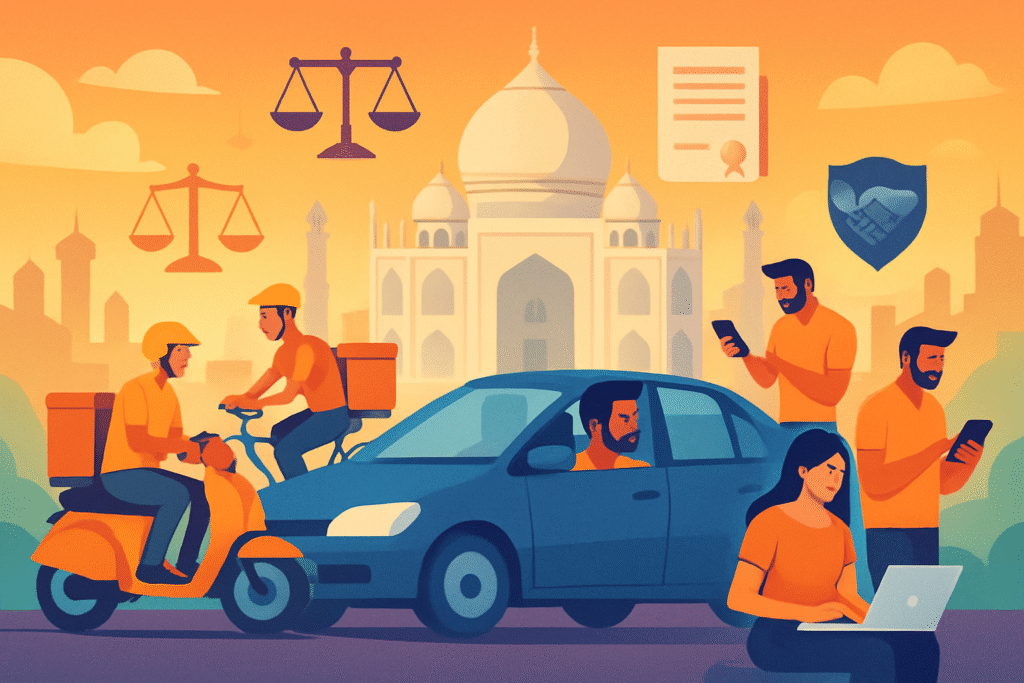Published On: 14th May, 2025
Authored By: Anukriti
MDU-CPAS, Gurugram
Introduction
Seven year old Rohan had always dreamed of seeing a mountain. He had read about the snow capped peaks of the Himalayas in his schoolbooks but had never seen one in real life. So, when he looked out of his car window one day and saw a massive peak rising in the distance, his eyes widened with excitement.
“Papa! Look! A mountain in Delhi!” he exclaimed.
His father smiled sadly. “That’s not a mountain, beta. That’s the Ghazipur landfill.”
Confused, Rohan asked, “But why does it look like a mountain?”
His father sighed, “Because it’s been growing for years- filled with garbage, mostly plastic waste. It’s so big now that birds mistake it for a natural hill.”
Rohan couldn’t stop thinking about it. How could something so dirty grow so high? Why hasn’t anyone stopped it? That evening, he searched for answers. He learned that plastic waste takes hundreds of years to break down, choking rivers, harming animals, and polluting the air,. The more he read, the more questions he had: Why is there so much plastic? Where does it all go? Are there rules to stop this?
This curiosity led him to a world of environmental laws and policies- rules meant to protect nature but often ignored.
Rohan’s discovery at the Ghazipur Landfill is a reflection of a larger growing crisis. India generates over 3.5 million tones of plastic waste annually, yet its disposal remains a major challenge. While laws exist to regulate plastic waste, their implementation remains weak. This article explores the legal framework on plastic waste management, its challenges, and the road ahead for a sustainable future.
Plastic Waste
Plastics have become an inseparable part of daily life, from household essentials to industrial applications. However, their chemical properties, which make them durable, also contribute to their persistence in the environment. While even a small amount of plastic is bad for people, some types are worse for the environment than others. Polystyrene, for example, degrades into tiny particles called micro-plastics that may easily penetrate ecosystems and oceans and destroy marine life.[1] According to the United Nations Environment Programme (UNEP), single-use plastics and microplastics pose the greatest threat due to their extensive production and inability to fully decompose.[2] Phthalates and dioxins, two dangerous compounds found in Polyvinyl Chloride, are known to cause cancer and interfere with hormones. Throughout the product’s existence, these chemicals may leak out, posing major health concerns.[3] Polycarbonate frequently contains BPA, a chemical that has been connected to a number of health issues, including cancer and hormone imbalances.[4]
Concerns regarding chemical pollutants, including plastics, were first widely recognized through Rachel Carson’s seminal work “Silent Spring” (1962), which highlighted the dangers of synthetic substances. While her research primarily focused on pesticides, it sparked a global movement toward stricter environmental regulations. Over the decades, industrial expansion and mass consumerism have led to a new environmental challenge- plastic waste.[5]
Today, India finds itself at the center of this crisis, with rapid urbanization and rising plastic consumption creating an unprecedented waste management challenge. In cities, the demand for single-use plastics and packaging materials has skyrocketed. According to a study that was published in Nature[6], India now contributes more plastic pollution than any other country in the world, making up about 20% of all global plastic waste generation. India’s annual contribution to this environmental disaster is greater than that of entire regions, with 9.3 million tonnes of plastic trash produced; 3.5 million tonnes of plastic garbage are mishandled and released into the environment annually.[7]
Individuals, animals, the marine environment, and the environment as a whole are gravely endangered due to the excessive amount of plastic trash produced. In 2019, the Organization for Economic Cooperation and Development (OECD) estimated that plastic items were responsible for 3.4% of global greenhouse gas emissions over their entire cycles.[8] “Globally, the annual production of plastics has doubled, soaring from 234 million tonnes (Mt) in 2000 to 460 Mt in 2019. Plastic waste has more than doubled, from 156 Mt in 2000 to 353 Mt in 2019.”[9] The World Economic Forum predicts that without action, the global plastics industry will account for 20% of overall oil consumption and up to 15% of world carbon emissions by 2050.[10] The WEF also stated in its report, the recycling rate for plastics in general is even lower than for plastic packaging, and both are far below the global recycling rates for paper (58%) and iron and steel (70–90%). In addition, plastic packaging is almost exclusively single-use, especially in business-to-consumer applications. “Plastic packaging generates significant negative externalities, conservatively valued by UNEP at $40 billion and expected to increase with strong volume growth in a business-as-usual scenario. Each year, at least 8 million tonnes of plastics leak into the ocean – which is equivalent to dumping the contents of one garbage truck into the ocean every minute. If no action is taken, this is expected to increase to two per minute by 2030 and four per minute by 2050. Estimates suggest that plastic packaging represents the major share of this leakage.” [11] Apart from this, International Union for Conservation of Nature (IUCN) in its report showed how microplastics are detrimental to human health. Microplastics have been detected in tap water, salt, and ocean samples around the world, including the Arctic.[12] As plastics travel with ocean currents, an island of trash called the “Great pacific Garbage Patch” has been created. There are now many islands of trash in our seas.[13] Chemicals used in plastic production can cause cancer and affect the endocrine system, resulting in developmental, reproductive, neurological, and immunological problems in people and animals. Long-term interaction with seawater causes hazardous contaminants to accumulate on plastic surfaces. Plastic pollution ingested by marine species gradually accumulates in the food chain, and when we consume seafood, toxins can be transmitted from marine species to us.[14]
Plastic Waste Management in India
Is the vast amount of plastic waste we produce entirely created and neglected? That would be incorrect, though, as the nations manage a good deal of the garbage that is produced. In 2017-18, the Central Pollution Control Board (CPCB) estimated that India generates over 9.4 million tonnes per annum plastic waste, (which amounts to 26,000 tonnes of waste per day), and out of this approximately 5.6 Million tonnes per annum plastic waste is recycled (i.e. 15,600 tonnes of waste per day) and 3.8 Million tonnes per annum plastic waste is left uncollected or littered (9,400 tonnes of waste per day).[15]
Recognizing the environmental and health risks caused by plastic pollution, India has passed many laws to restrict plastic waste disposal and promote sustainable waste management.
- The Plastic Waste Management Rules, 2016 and Amendments
The Plastic Waste Management (PWM) Rules, 2016[16] were a landmark law aiming at reducing plastic pollution through Extended Producer Responsibility (EPR), phasing out non-recyclable plastics, and requiring local governments to adequately manage plastic waste. Key elements include a ban on plastic bags below 50 microns, which discourages the use of thin plastic that cannot be recycled successfully. Manufacturers and importers must take responsibility for plastic garbage generated by their products. Households and companies should segregate plastic garbage from biodegradable waste.[17]
The Plastic Waste Management (Amendment) Rules, 2022[18] prohibit single-use plastics (SUPs) including plastic cutlery, plates, straws, and polystyrene decorations. It further enhanced EPR processes by mandating businesses to track and report their plastic waste creation and recycling activities via a centralized platform.[19]
The Plastic Waste Management (Amendment) Rules, 2024, notified on March 14, 2024[20], made significant changes:
• The amendment defines biodegradable plastics as materials that can be degraded by biological processes in particular conditions, such as soil and landfill, without producing microplastics.
• Microplastics are described as solid plastic particles that are insoluble in water and range in size from 1 to 1,000 microns.
• The amendment allows for the production of carry bags and commodities made from compostable or biodegradable plastics, with mandatory marking and labeling in accordance with Food Safety and Standards Authority of India regulations for food contact.[21]
- The Food Safety and Standards (Packaging) Regulation, 2018[22]
- Regulates plastic packaging used in the food sector to avoid contamination and maintain safety.
- Forbids the use of recycled plastic to store, package, or sell food.[23]
- The Environment (Protection) Act, 1986[24]
- Section 7 of the Act prohibits emitting or discharging pollutants that exceed the established criteria.
- According to Section 9 of the Act, if an event hurts the environment, the responsible party must prevent or mitigate the pollutant emitted as a result of the event. The individual must notify the appropriate authorities if an event poses an environmental risk.[25]
International Legal Framework
Measures for managing plastic trash have been adopted not only in India, but also globally.
- OECD Global Plastics Outlook
The Global Plastics Outlook examines two policy packages aimed at improving circularity and reducing environmental impact by 2060. The Regional Action package, more ambitious for OECD countries, aims to ensure economic growth while reducing plastic leaks. By 2060 in OECD countries, plastics use is projected to fall by 16% (69 Mt) compared to the Baseline and by 18% (144 Mt) in non-OECD countries. The Global Ambition package, on the other hand, aims to reduce plastic leakage to nearly zero by 2060. By 2060, global plastic leakage to the environment is projected to decrease by 85% compared to the Baseline scenario, from 44.2 Mt to 6.4 Mt. This is an additional 30 percentage point decrease below the reductions projected for the Regional Action scenario.[26]
- United Nations Environment Assembly (UNEA) Resolution 5/14[27]
Resolution 5/14, titled “End plastic pollution: Towards an International Legally Binding Instrument,” advocates for the creation of a legally enforceable instrument on plastic pollution, notably in the maritime environment.[28]
India, being a signatory to global environmental agreements like the Basel Convention and UNEA 5/14, is expected to align its national policies with these international commitments.
Case Studies
Operation Blue Mountain in Nilgiris, Tamil Nadu[29]
In 2001, Supriya Sahu, the district collector, launched the Operation Blue Mountain campaign to outlaw plastic use in the district. The campaign was critical for clearing the river headwaters and springs in the popular hill station of Nilgiris. The initiative was documented by the former Planning Commission and UNDP as a best practice in governance from Indian states. The campaign featured photographs of suffocating animals to convey its message. Plastic clogs drains and leaks into lakes and other bodies of water.
Sikkim: First State to Ban Plastics Bottles & Disposable Foam Products
Sikkim, a small state in northeastern India, has become a leading environmental leader by banning disposable plastic bags and single-use plastic bottles. In 2016, the state banned packaged drinking water in government offices and Styrofoam and thermocol disposable plates and cutlery to reduce toxic plastic pollution and address its growing garbage problem.[30]
“What happened was that in one episode in the 1990s, plastic carry bags got washed down due to heavy rainstorm. Drains got blocked, which resulted in huge landslide. Some people died too. This triggered the state government to ban plastic bags,” said Rajendra P Gurung, CEO, Ecotourism and Conservation Society of Sikkim (ECOSS), a local NGO that works in Sikkim.[31]
Challenges
Each policy implementation has unique problems. Even if there are many laws, only a select group of individuals follow them when they are implemented. Let’s look at some specific issues that we encounter with managing plastic garbage, and it’s not just India; countries around the world face similar challenges.
The most common issue is a lack of understanding, and even when people are aware, they attempt to gaslight others. Although laws are vital, they won’t be difficult to apply until people embrace them and actively participate in the country’s efforts to manage garbage.
Lack of trash segregation at the source: Sorting trash by hand is the oldest and simplest technique of segregating plastic. In developing nations such as India, each form of plastic must be manually separated before it can be recycled. This results in an inefficient and inconsistent sorting process.[32]
The Plastic Waste Management Rules (PWR), introduced in 2011, aimed to manage plastic waste and ensure scientific management. The rules assigned responsibilities to urban local bodies and established a state-level monitoring committee, set minimum standards for carry bags and mandated retailers to charge fees. The rules were later revised in 2016 to include rural areas and plastic importers. The minimum thickness of plastic carry bags was increased from 40 micron to 50 micron, and a collect back system called Extended Producers Responsibility (EPR) was introduced, introduced a centralized registration system for brands and producers operating in multiple states. Despite these changes, concerns remain about the plastic menace.[33]
Way Forward
Plastic waste management in India requires a fundamental shift from a linear economy, where plastic is used and discarded, to a circular economy, where waste is minimized through reuse, recycling, and sustainable production. This approach ensures that plastics remain part of the economy but do not become an environmental burden. It encourages industries to design biodegradable alternatives, promotes waste to resource innovations, and emphasizes consumer responsibility in reducing plastic consumption.
India’s efforts to tackle plastic pollution align closely with the Sustainable Development Goals (SDGs). SDG 12 (Responsible Consumption and Protection) calls for sustainable waste management, while SDG 13 (Climate Action) highlights the need to reduce plastic related emissions. Additionally, SDG 14 (Life below Water) and SDG 15 (Life on Land) focus on protecting ecosystems from plastic pollution. Strengthening the Plastic Waste Management Rules, 2016, enhancing Extended Producer Responsibility (EPR) compliance, and investing in eco- friendly innovations are essential steps forward.
The government and industry must collaborate to establish effective and sustainable EPR implementation models for plastic waste management. Real-time assessments and state-wise mapping of producers, plastic demand, and supply are needed to formulate realistic targets. Pilot EPR models for low-hanging fruits, such as completely recyclable PET, should be prioritized. India should explore successful models in other countries where producers take responsibility for product end-of-life.[34]
Conclusion
To address this crisis effectively, legal enforcement must work alongside behavioral change. Government regulations, corporate responsibility, and citizen participation must come together to create a sustainable waste management system. The Ghazipur garbage mountain, once a child’s mistaken curiosity, serves as a grim reminder of the consequences of unchecked plastic waste. If we commit to circular economy and stricter environmental governance, we can transform plastic waste from a growing problem into an opportunity for sustainability and innovation.
Reference(s):
[1] Mother Earth, ‘The Top 3 Worst Plastics for the Environment’ (February 09, 2025) https://memotherearthbrand.com/blogs/plastic-free-living/the-top-3-worst-plastics-for-the-environment accessed 21 March, 2025
[2] United Nations Environment Programme (UNEP), ‘Single Use Plastics: A Roadmap for Sustainability’ (26 March 2018) https://www.unep.org/resources/report/single-use-plastics-roadmap-sustainability accessed 20 March, 2025
[3] Ibid 2
[4] Ibid 2
[5] Rachel Carson, “Silent Spring” (Houghton Mifflin, 1962)
[6] Cottom, J.W., Cook, E. & Velis, ‘C.A. A local-to-global emissions inventory of macroplastic pollution’ Nature 633, 101–108 (2024). https://doi.org/10.1038/s41586-024-07758-6
[7] Plastics for Change, ‘India Emerges as the Worlds’s Largest Plastic Polluter: What went wrong and What’s Next?’ https://www.plasticsforchange.org/blog/india-emerges-as-the-worlds-largest-plastic-polluter-what-went-wrong-and-whats-next
[8] United States Environmental Protection Agency, ‘Impacts of Plastic Pollution’ (23 April, 2024) https://www.epa.gov/plastics/impacts-plastic-pollution
[9] Organisation for Economic Cooperation and Development, ‘Global Plastics Outlook: Economic Drivers, Environmental Impacts and Policy Options’ (February 2022) 3 https://www.oecd.org/content/dam/oecd/en/publications/support-materials/2022/02/global-plastics-outlook_a653d1c9/Global%20Plastics%20Outlook%20I.pdf
[10] Ibid 9
[11] World Economic Forum, ‘The New Plastics Economy: Rethinking the Future of Plastics’ (January, 2016) 5 https://www3.weforum.org/docs/WEF_The_New_Plastics_Economy.pdf
[12] IUCN, “MARINE PLASTIC POLLUTION” (2021) https://www.iucn.org/sites/default/files/2022-04/marine_plastic_pollution_issues_brief_nov21.pdf
[13] Ministry of Housing & urban affairs, governMent of india, “Plastic Waste ManageMent Issues, Solutions & Case Studies” (2019) http://swachhbharaturban.gov.in/writereaddata/SBM%20Plastic%20Waste%20Book.pdf
[14] Ibid 13
[15] CIPET:SARP-APDDRL, UNIDO Office, and Government of India, “RECYCLING OF PLASTICS IN INDIAN PERSPECTIVE” https://www.unido.org/sites/default/files/files/2018-11/Plenary%202%20-%20Plastics%20-%20Mohanty.pdf
“CPCB | Central Pollution Control Board” (CPCB) http://cpcb.nic.in/Plastic_waste.php/
[16] “Government Notifies Plastic Waste Management Rules, 2016” (n 2).
[17] “Government Notifies Plastic Waste Management Rules, 2016” https://pib.gov.in/newsite/printrelease.aspx?relid=138144 accessed 21 March, 2025
[18] Plastic Waste Management (Amendment) Rules, 2022
[19](Drishti IAS) “Plastic Waste Management (Amendment) Rules, 2022” https://www.drishtiias.com/daily-news-analysis/plastic-waste-management-amendment-rules-2022 accessed 21 March, 2025
[20] Plastic Waste Management (Amendment) Rules, 2024
[21] VisionIAS, “PLASTIC WASTE MANAGEMENT | Current Affairs | Vision IAS” (Current Affairs | Vision IAS, May 10, 2024) https://visionias.in/current-affairs/monthly-magazine/2024-04-15/environment/plastic-waste-management accessed 21 March, 2025
[22] The Food Safety and Standards (Packaging) Regulations, 2018
[23] Food Safety and Standards Act, “Food Safety and Standards (Packaging) Regulations, 2018” (2022) S.4(e) https://fssai.gov.in/upload/uploadfiles/files/Compendium_Packaging_Regulations_09_09_2022.pdf
[24] The Environment (Protection) Act, 1986
[25] Post G, “Waste Management Laws in India – IPleaders” (iPleaders, October 11, 2019) https://blog.ipleaders.in/waste-management-laws-india/ accessed 21 March, 2025
[26] OECD (2022), ‘Global Plastics Outlook: Policy Scenarios to 2060’, OECD Publishing, Paris, https://doi.org/10.1787/aa1edf33-en. accessed 21 March, 2025
[27] United Nations Environment Programme, “Ad Hoc Open-Ended Working Group to Prepare for the Work of the Intergovernmental Negotiating Committee to Develop an International Legally Binding Instrument on Plastic Pollution, Including in the Marine Environment” (2022) https://wedocs.unep.org/bitstream/handle/20.500.11822/39812/OEWG_PP_1_INF_1_UNEA%20resolution.pdf
[28] Ojoleck B and Pizarro C, “Global Legal and Policy Frameworks on Plastics: An Introduction” (UNEP) https://indico.un.org/event/1003056/attachments/6653/18114/5.%20Plastic%20Pollution_Law%20Div_21Oct2022_for%20translation.pdf
[29] Ministry of Housing and Urban Affairs, ‘Plastic Waste Management: Issues, Solutions and Case Studies’ https://sbmurban.org/storage/app/media/pdf/SBM%20Plastic%20Waste%20Book.pdf accesses 21 March, 2025
[30] United Nations Environment Programme, “How the Indian State of Sikkim Is Working to End Plastic Pollution” (UNEP) https://www.unep.org/news-and-stories/story/how-indian-state-sikkim-working-end-plastic-pollution
[31] Ibid 30
[32] Recykal, “5 Major Challenges in Plastic Waste Recycling” (Recykal, February 9, 2023) https://recykal.com/blog/5-major-challenges-in-plastic-waste-recycling-recykal/ accessed 21 March, 2025
[33] “Plastic Waste Management in India: Challenges and Opportunities” https://www.teriin.org/sites/default/files/2018-06/plastic-waste-management_0.pdf
[34] Ibid 33





Your message highlights an urgent and important issue with genuine concern and a call for action.
**Say No to Plastic: A Wake-Up Call for Our Future**
In recent years, the use of plastic in our daily lives has increased to an alarming level. Almost every product we buy comes in plastic packaging. Unfortunately, developing countries like ours often lack an efficient plastic waste management system. Even worse, some nations dump their plastic waste directly into the oceans, severely affecting marine life and the environment.
To tackle this crisis, we must adopt some essential practices to reduce plastic use:
1. **Choose Alternatives:** Use cloth or paper bags instead of plastic bags. If you must use plastic, make sure to reuse it. In some states, plastic bags have been banned and fines are imposed on shops violating this rule—but sadly, these efforts often fade away after a few months. Consistency and strict implementation are necessary.
2. **Avoid Bottled Water:** Single-use plastic water bottles contribute significantly to plastic pollution. For example, in my office after COVID-19, the management started providing packaged water bottles, resulting in the consumption of 400–500 bottles per day for just 300 people. That’s a huge amount of daily plastic waste.
3. **Say No to Single-Use Plastics:** Avoid disposable plastic cutlery, straws, and non-recyclable plastic items. Choose reusable alternatives like refillable bottles, reusable shopping bags, travel cutlery, and cups. Also, be mindful of excessive plastic packaging.
4. **Promote Reuse and Recycling:** Plastic cannot be eliminated overnight due to its multipurpose nature. However, we can reduce its impact by reusing and recycling. Reprocessing used plastic into new products helps divert waste from landfills and oceans.
5. **Educate and Raise Awareness:** Education plays a crucial role. Many people still don’t understand the long-term damage caused by plastic pollution. By spreading awareness, we can inspire people to make more sustainable choices. This can lead to real behavioral change, especially for the sake of future generations.
6. **Creative Reuse:** Use plastic items creatively—reuse bottles for watering plants, storing homemade products, or even as containers for shampoo. Repurpose them as bin liners, for dirty laundry, or even transform them into bird feeders.
7. **Follow the 3Rs: Reuse, Reuse, and Reuse—until the item reaches a non-reusable condition.** This mindset can greatly reduce plastic waste.
A Message for the Future
The plastic crisis is not someone else’s problem—it’s ours. If we don’t act now, our children and future generations will inherit a polluted planet. They may ask us one day: “You had the chance to fix this—why didn’t you?”
It’s time to act. Let’s reduce our plastic use, embrace sustainable alternatives, and work together to protect the only home we have—our planet.
What a researched article🫡
Fabulous work Dear AUTHOR !🫡
Love how it starts with a story to build curiosity followed by an outstanding explanation. Thankyou for thissss.
Great job breaking down a complex legal topic so clearly. Keep up the good work